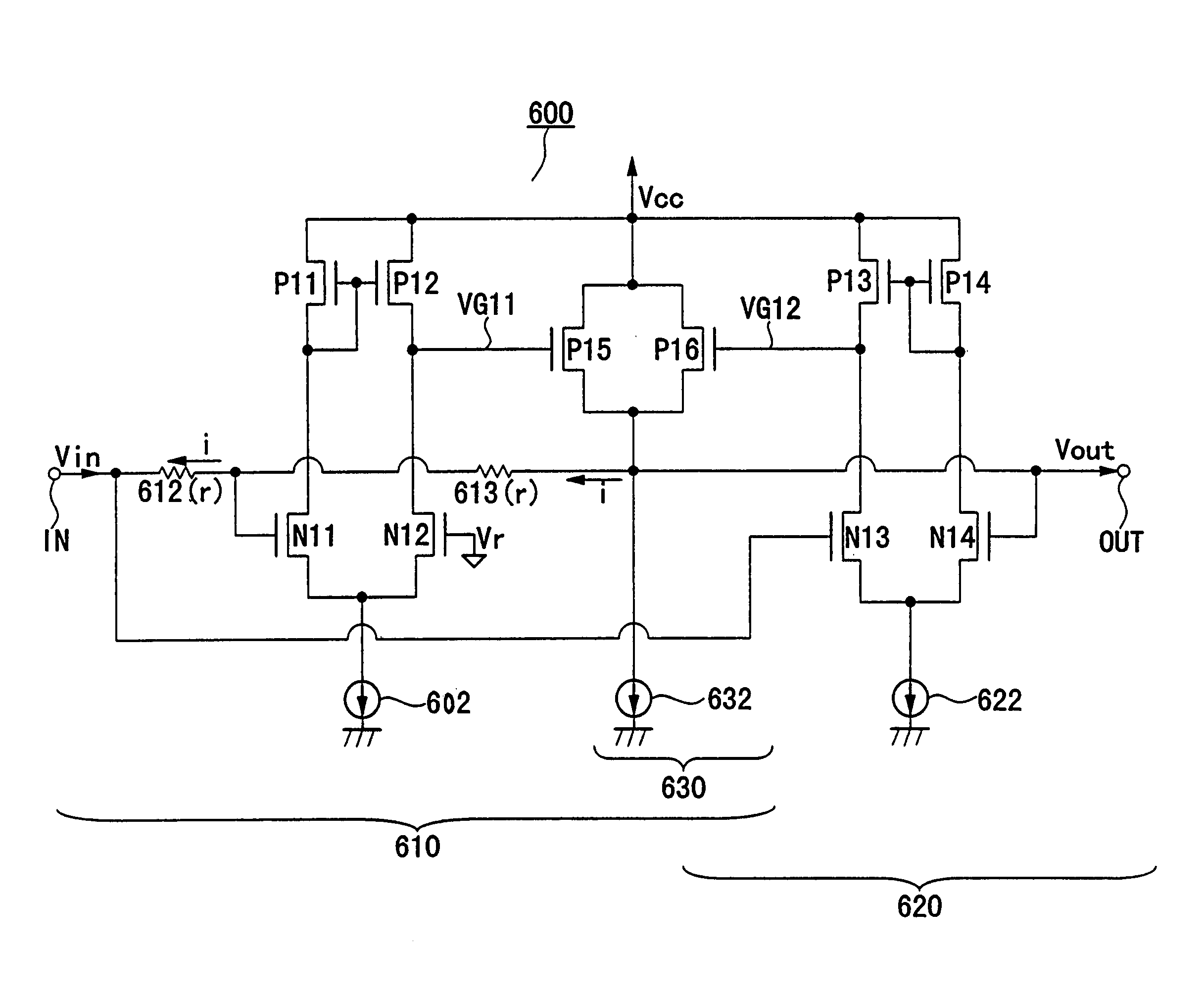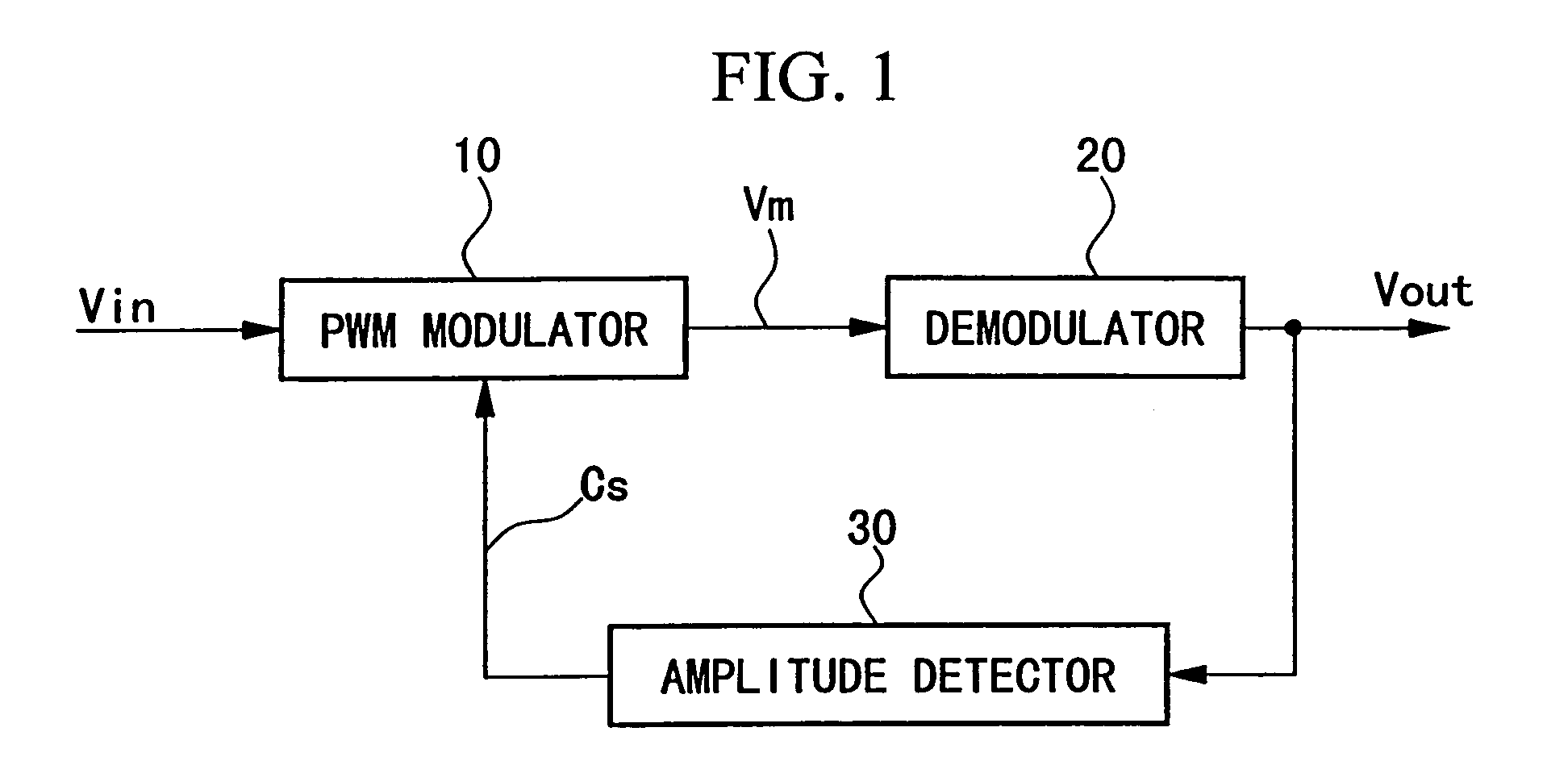Device for amplitude adjustment and rectification made with MOS technology
a technology of amplitude adjustment and rectification, applied in the direction of negative-feedback-circuit arrangement, ac-dc conversion, gain control, etc., can solve the problems of amplitude compression device problems, amplitude compression device manufacturing in accordance with the mos process, and the driver is difficult to listen to the piano sounds which are performed in pianissimo
- Summary
- Abstract
- Description
- Claims
- Application Information
AI Technical Summary
Benefits of technology
Problems solved by technology
Method used
Image
Examples
embodiment 1
[A] Embodiment 1
[0052]Now, a description will be given with respect to a circuit configuration of an amplitude compression device in accordance with embodiment 1 of the invention. FIG. 1 is a block diagram showing the amplitude compression device of the embodiment 1. The amplitude compression device of FIG. 1 contains a PWM modulator 10 (where “PWM” is an abbreviation for “Pulse-Width Modulation”), a main part of which is configured by a self-sustaining oscillation circuit. Herein, the PWM modulator 10 performs pulse-width modulation on an input signal Vin in response to a modulation factor, which is determined by a control signal Cs. Thus, the PWM modulator 10 produces and outputs a pulse-width modulated signal Vm.
[0053]A demodulator 20 is configured using a low-pass filter. The demodulator 20 demodulates the pulse-width modulated signal Vm to produce an output signal Vout. The low-pass filter has “flat” frequency characteristics in a frequency band of the input signal Vin. In addi...
embodiment 2
[B] Embodiment 2
[0077]Next, a description will be given with respect to a configuration of an amplitude compression device in accordance with embodiment 2 of the invention.
[0078]FIG. 5 is a block diagram showing the amplitude compression device of the embodiment 2. Like the aforementioned embodiment 1 shown in FIG. 1, the amplitude compression device of the embodiment 2 is configured by the PWM modulator 10, the demodulator 20 and the amplitude detector 30. However, different from the embodiment 1 in which the output signal Vout is detected to produce the control signal Cs, the embodiment 2 is designed such that the amplitude detector 30 detects the amplitude of the input signal Vm to produce the control signal Cs. In other words, the embodiment 1 is configured in a feedback form, while the embodiment 2 is configured in a feed-forward form.
[0079]FIG. 6 is a circuit diagram showing internal circuit configurations of the amplitude compression device of the embodiment 2, wherein parts ...
embodiment 4
[D] Embodiment 4
[0105]The aforementioned full-wave rectifier 500 of the embodiment 3 is designed to produce the “negative” output signal Vout. In contrast, a full-wave rectifier 600 of the embodiment 4 is designed to produce a “positive” output signal Vout.
[0106]FIG. 9 is a circuit diagram showing circuit configurations of the full-wave rectifier 600 in accordance with the embodiment 4, wherein parts equivalent to those of FIG. 7 are designated by the same reference symbols.
[0107]The full-wave rectifier 600 of FIG. 9 is mainly configured by an inversion amplifier 610, an amplifier 620 and an output section 630, which are basically equivalent to the inversion amplifier 510, the amplifier 520 and the output section 530 shown in FIG. 7.
[0108]The inversion amplifier 610 is configured by a constant current source 602, a pair of n-channel FETs N11, N12, a pair of p-channel FETs P11, P12 which act as active loads, and resistors 612, 613 as well as the output section 630. In the inversion a...
PUM
 Login to View More
Login to View More Abstract
Description
Claims
Application Information
 Login to View More
Login to View More - R&D
- Intellectual Property
- Life Sciences
- Materials
- Tech Scout
- Unparalleled Data Quality
- Higher Quality Content
- 60% Fewer Hallucinations
Browse by: Latest US Patents, China's latest patents, Technical Efficacy Thesaurus, Application Domain, Technology Topic, Popular Technical Reports.
© 2025 PatSnap. All rights reserved.Legal|Privacy policy|Modern Slavery Act Transparency Statement|Sitemap|About US| Contact US: help@patsnap.com



